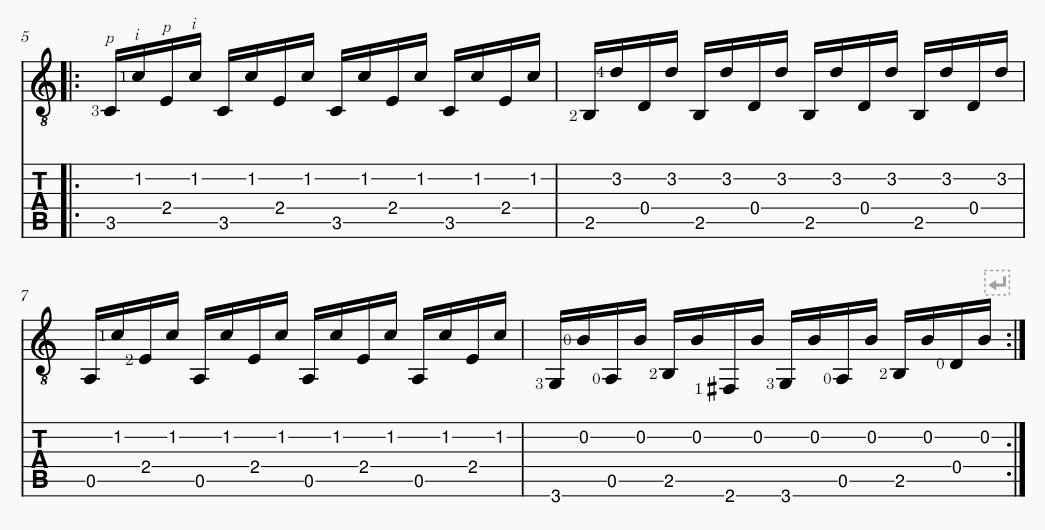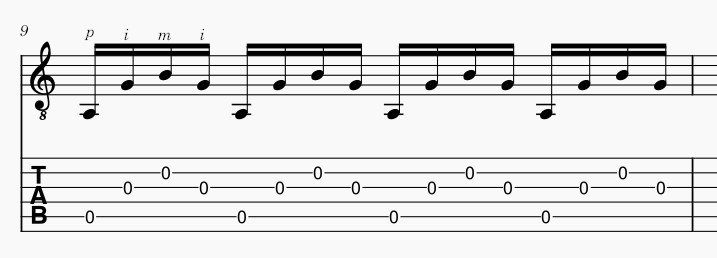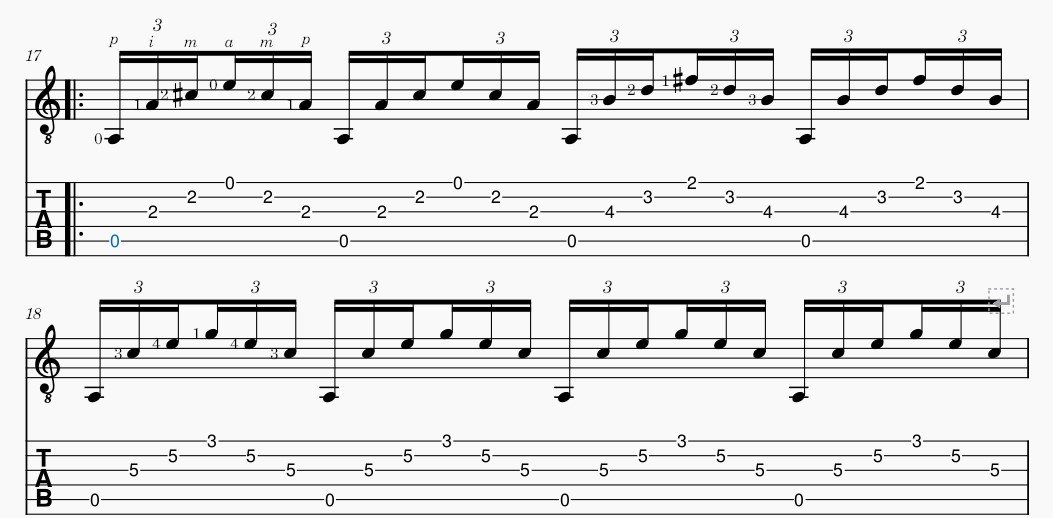Mastering fingerstyle guitar is like a pianist perfecting two-handed independence. It’s a journey that demands discipline, precision, and methodical practice.
In this article I’ll show you seven short exercises you can use to practice different fingerstyle techniques. I composed all of these myself. From understanding the basics, incorporating finger picking patterns, to mastering complex pieces, these routines will serve as a guide to expedite your progress.
Aimed at both beginners and seasoned guitarists, this comprehensive guide will help you navigate the intricate world of fingerstyle guitar.
How To Read Guitar Fingering Notation
The examples below include fingering notes for the right (plucking) and left (fretting) hands.
Right hand:
- Thumb = p
- Index = i
- Middle = m
- Ring = a
Left hand:
- Index = 1
- Middle = 2
- Ring = 3
- Pinky = 4
If you see a letter, it refers to the plucking hand. If you see a number, it refers to the fretting hand (applies to the treble cleff staff, not tab)
Fingerstyle Guitar Exercise #1: Thumb and Index (Open Strings)

Here’s a very basic exercise to get things started. It’s based on plucking with your thumb and index finger back and forth. You should be able to follow this exercise and play the open strings evenly before adding notes, which we’ll do in the next exercise.
Notice that your thumb alternates between the A and D strings, while your index is always plucking the B string.
You can play these exercises at any speed, it doesn’t need to be fast even though I wrote them in 16th notes.
Fingerstyle Guitar Exercise #2: Thumb and Index (With Chords)

This exercise is the same right hand pattern as the last one. The difference is your left hand is going through different chord shapes as you play the pattern.
The main chord progression is C, G/B, Am, and G. There are fingering suggestions for each chord shape. Since this is a fingerstyle exercise, you don’t play all the notes in a standard C chord, just the notes in the exercise.
The fourth measure has a melody in the bass notes which switches things up a little bit.
Fingerstyle Guitar Exercise #3: Thumb, Index, and Middle (Open Strings)

Now we add the middle finger to the plucking mix. Try this exercise slowly to get used to it. You might notice adding the middle finger isn’t very difficult. this is because the index and middle fingers both have good independence with hand muscles and tendons. This isn’t the same story with the ring finger, as we’ll see later.
This exercise in particular is modeled after old Spanish etudes for the guitar from composers like Fernando Sor.
Fingerstyle Guitar Exercise #4: Thumb, Index, and Middle (With Chords)

Now we’ll add some notes to the simple three-finger arpeggio. Immediately, it becomes much harder. You can take time to practice the fingering and chord positions of the right hand without worrying about the plucking pattern to get it down first. Then, put them together.
These notes outline a different chord progression:
A Bm/A C/A C/A G/A B/A Bb/A A
I tried to create something interesting to the ear while your fingers go to work on the plucking pattern.
Fingerstyle Guitar Exercise #5: Thumb, Index, Middle, and Ring (Open Strings)

Now we’re getting to the more complex patterns. This one incorporates the ring finger in a simple sixteenth-note triplet arpeggio. (Again, you don’t have to play this fast.)
I always notice it takes just a bit more effort and concentration to get the ring finger to pluck a note smoothly. You might also think it sounds different or a bit thin compared to your other fingers. That’s OK. Just take it slow and work on it.
Fingerstyle Guitar Exercise #6: Thumb, Index, Middle, and Ring (With Chords)


Now we’ll add notes to the last exercise with the sixteenth-note triplet arpeggio. These notes follow the same chord progression as Exercise #4 except I added notes on the high E string to finish out the triad.
It’s a good idea to practice the left and right hands separately. So, take some time to play the triads slowly through this exercise. Then, you can add the right hand fingerstyle pattern once you have the left hand down.
Fingerstyle Guitar Exercise #7: Ring Finger-Twister

Now we’ve come to the final exercise. This is a brand new pattern and melody. This time, the melody is just on the low E string and all the other notes are open strings. But looks can be deceiving.
This has one of the trickiest patterns I’ve come across: you alternate index and middle fingers while playing the ring finger in between. There’s something so uncomfortable about using the ring finger this much. Throw in some simultaneous notes with your thumb on the low E string and this is definitely a tricky pattern.
Understanding Fingerstyle Guitar Basics
The foundation of mastering fingerstyle guitar lies in understanding its principles and techniques. Fingerstyle fundamentals cover a broad spectrum; from plucking accuracy to finger placement, each element plays a crucial role.
Guitar tuning methods, too, are integral to the fingerstyle approach. The guitar’s tonal quality and the ease of playing certain chords are largely dependent on the tuning method employed. Various methods like standard, open, and alternate tunings each offer unique sound characteristics and difficulties. Certain songs are iconic on fingerstyle guitar because they were written in an alternate tuning.
Advanced Finger Independence Exercises
In pursuit of advancing one’s fingerstyle guitar proficiency, getting into advanced finger independence exercises is an indispensable step. These exercises aid in strength training and dexterity improvement, which can enhance your fingerstyle performance.
Here are some exercises to consider:
- Exercises that involve alternate finger picking, fostering dexterity and improving coordination.
- Strength training exercises, such as finger lifts, to enhance the power and endurance of your fingers.
- Complex chord progression exercises to challenge and enhance your finger independence.
- Single-string exercises for focusing on individual finger strength and precision.
- Speed drills to push your fingers’ responsiveness and agility.
These exercises, when integrated into regular practice, can substantially improve your fingerstyle guitar skills and take your playing to the next level.
Rhythm and Timing Drills
With respect to enhancing fingerstyle guitar proficiency, incorporating rhythm and timing drills into your practice routine is also important. This can help your timing precision and also contribute to the development of a personal rhythmic feel.
Metronome practice is a fundamental aspect of these drills, as it maintains a steady pulse, enabling you to accurately measure your timing and rhythm. Start with a comfortable pace and gradually increase it. You should be able to make the metronome groove and almost disappear as you play perfectly on time.
It’s also beneficial to experiment with different rhythmic patterns and syncopations. Remember, having a keen sense of timing and rhythm is vital, as it provides the backbone to any musical piece, ensuring your performance remains engaging and dynamic.
Mastering Complex Fingerstyle Pieces
Building upon your percussive techniques, the next stage in your fingerstyle guitar practice involves tackling complex pieces that challenge your technical proficiency and musical interpretation.
Essential steps for mastering complex fingerstyle pieces include:
- Fingerstyle Repertoire Building: Devote time to expanding your collection of complex pieces. Experiment with different genres to enhance your versatility.
- Slow Practice: Begin by playing the piece slowly, gradually increasing speed as you gain confidence.
- Sectional Practice: Break down the piece into smaller sections and focus on mastering each one individually.
- Emotional Expression Techniques: Convey the mood of the piece through dynamics and phrasing.
- Consistent Review: Regularly revisit previously learned pieces to ensure they remain part of your active repertoire.
Effectively mastering complex fingerstyle pieces requires dedication, but the reward is a richer, more satisfying playing experience.
Put the Pedal to the Metal
Once I get comfortable with a fingerstyle pattern, I don’t just want to play it up to normal speed. I want to play it much faster, even twice as fast. Of course, I’ll never perform it at this speed, and it often sounds goofy and really messy. But if you can play something much faster than it should be, you’ll be more comfortable going back to the normal speed.
Guitar Fingerstyle Exercises: Conclusion
Through diligent and systematic practice, mastering fingerstyle guitar is totally possible. These seven practice routines can help you in your journey, but they just scratch the surface. Keep exploring exercises and different songs to give yourself a good range of practice material.
Further Reading
Check out the links below for more fingerstyle guitar material:
- Exercises (advanced) – Fingerstyle.com
- Finger Picking Exercises – Blues Guitar Institute
- Unlock Rapid Fingerpicking Guitar Techniques with These Exercises – Pickup Music
- Learn These 3 Fingerpicking Exercises for Guitar And Sound Like A Pro (acousticguitarlessonsonline.net)
- Fingerstyle Guitar Lesson – Basic Exercises For Beginners (jazz-guitar-licks.com)


